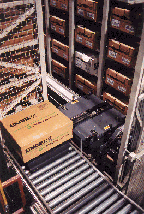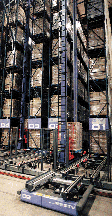Automated System Excels at Beef Distribution Facility; Achieves Fast, Flexible Distribution
With its ability to quickly and accurately configure full pallet loads, mixed pallet loads, and floor-loaded orders, the system gives Excel a world-class distribution facility
Ask Our Experts!
![]() PDF Version; 278KB
PDF Version; 278KB
Customer:
Excel Beef http://www.excelmeats.com
Application:
Beef fabrication and distribution facility
The situation:
Excel, a division of Cargill Foods, is one of the nation's leading beef suppliers, processing several thousand head of cattle a day in Plainview, TX. Today's beef customers - from large grocery chains to specialty restaurants - increasingly demand shorter lead times, smaller lots, and fresh, high-quality products.
The impact:
Boxes of beef were stored on manually loaded flow racks. Paper-based order picking was inefficient and often inaccurate. In addition, workers had to handle boxes weighing as much as 110 pounds, further slowing the process and leading to damaged boxes.
As business grew and customer demands became more complex, Excel realized that its manual order fulfillment system could not provide the necessary level of service.
Desired solution:
Buffer and sort up to 30,000 boxes of beef per day, allowing for order customization. Improve worker safety and ergonomics while ensuring product freshness.
Solution implemented:
Integrated material handling system featuring unit load AS/RS and conveyors.
A brief tour of the Excel distribution center illustrates how the system works. Primary cuts of beef are carefully Cryovac-wrapped and packed in boxes. Each box contains the same product. The boxes are bar code labeled with the product cut, grade, and net weight, which can be up to 110 lbs.
Cryovac-wrapped and packed in boxes. Each box contains the same product. The boxes are bar code labeled with the product cut, grade, and net weight, which can be up to 110 lbs.
The boxes then travel across a skyway conveyor into the new distribution center, which is kept at a constant 28°F to ensure product freshness. As the boxes move along the skyway, a laser scanner reads the bar code label and updates the inventory.
The control system then decides the destination of each box. Some are immediately sent to accumulation lanes to be palletized; some are stored in a mini load buffer until a full pallet can be accumulated.
Because some of Excel's orders are for full and mixed pallet loads of product while others are for mixed loads of individual boxes, the system is designed to easily accommodate all possible combinations. For example, individual boxes destined for floor loading onto trucks are pulled from the storage buffer, sorted, accumulated by customer line item, and released to one of four floor-loading dock areas.
Boxes that are to be palletized are sent to one of 20 accumulation conveyors. When a full pallet load is accumulated, the boxes are released to an automatic palletizer. Pallets can be created in several different stacking patterns, depending on the product type and box size. The pallet loads are stretch-wrapped for stability; then a Sorting Transfer Vehicle (STV) picks up the wrapped pallets and delivers them for storage in a unit load buffer.
As trucks for pallet-loaded goods arrive, the system retrieves the required pallets and delivers them to an STV. The STV then takes the pallet to an output conveyor, where a lift truck picks up the pallet and loads it onto the truck.
Throughout the process, control software directs all aspects of system operation in real time. This state-of-the-art control system, running on Windows NT, is built on client/server architecture, distributed controls, and a relational database.
Orders are transmitted from Excel's host computer, and may be modified at any time prior to being released for filling. This flexibility allows Excel to offer customers an extra measure of service.
Hardware installed at Excel Beef
- Eight-aisle MSS II automated box buffer with 3,500 storage locations
- Eight-aisle mini load automated buffer with 23,600 storage locations
- Two-level conveyor system with shoe sorters for transporting boxes to storage buffers, accumulation lanes, and loading docks
- 20 accumulation conveyor lanes for pallet loads
- Two automatic palletizers and shrink-wrap stations
- Four floor-running Sorting Transfer Vehicles (STV) for transporting pallets to and from the unit load buffer
- Real-time control software with interface to Excel's host computer
The results:
- Flexibility to ship full pallets, mixed pallets, and box orders from one distribution center
- First-in, first-out order filling for guaranteed freshness
- Accurate, efficient order picking with 100% real-time inventory control
- Precise automated handling, reducing box damage

With the new system, Excel is able to sort, store, and ship boxes using high-speed automated sorters, conveyors, and buffers. Every box is tracked in real time. As customer orders are filled, the system ensures that each shipment is filled exactly as ordered and delivered on schedule.
The success of the system can be attributed in part to the design-build partnership between the parties. Every component is designed for efficient material flow and high reliability in a demanding refrigerated environment. Extensive computer simulation helped refine and prove the system's design concepts and operating parameters before the system was installed.
With its ability to quickly and accurately configure full pallet loads, mixed pallet loads, and floor-loaded orders, the system gives Excel a world-class distribution facility able to process up to 30,000 boxes every day - so that Americans can enjoy fresh, high-quality beef on the dinner table.



